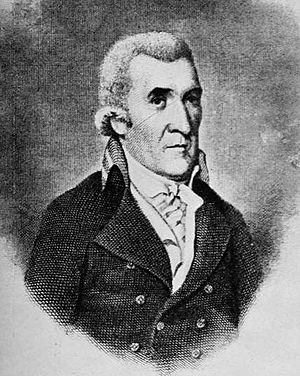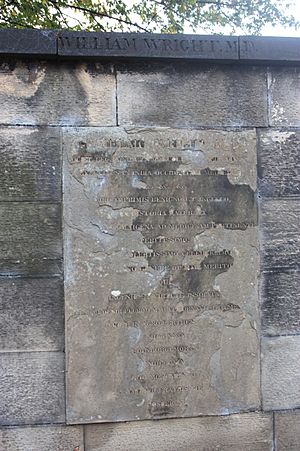William Wright (botanist) facts for kids
William Wright (1735–1819) was a Scottish doctor and expert in plants, known as a botanist. He was also a slave owner. In 1783, he helped start the Royal Society of Edinburgh, a famous group for scientists.
A Life of Learning and Travel
William Wright was born in March 1735 in Crieff, Perthshire, Scotland. He went to Crieff Grammar School. From 1752 to 1756, he trained to be a doctor in Falkirk. Later, he studied medicine at the University of Edinburgh.
Early Career and Time in the West Indies
In 1758, Wright joined the Royal Navy as a surgeon. He worked in the West Indies until 1763. He earned his medical degree (MD) from St Andrews University in 1763. In 1774, he became a member of the American Philosophical Society.
In 1764, Wright moved to Kingston, Jamaica. He worked as an assistant doctor on a sugar plantation. While there, he used the money from his medical work to buy enslaved people and land. He partnered with another doctor, Dr Thomas Steel, to build the Orange Hill estate. On this estate, he was responsible for the medical care of about 1200 enslaved people, as well as the local free people. By 1771, Wright owned thirty-three enslaved people. He was against ending slavery.
During his time in Jamaica, Wright became very interested in plants. He collected many Jamaican plants and became known as a botanist. In 1774, he was made Surgeon General of Jamaica. He stayed on the island until 1777, then spent two years in London. In 1779, he joined the British Navy again but was captured by the French.
He went back to Jamaica in 1782. The next year, he became the chief doctor for the colony. In 1784, he sold his property in Jamaica after Dr. Steel died. The money from these sales supported him for the rest of his life.
Return to Scotland and Later Years
Wright returned to Scotland in 1786 and mostly lived in Edinburgh. From 1796 to 1798, he joined an expedition led by Sir Ralph Abercromby to explore the Caribbean.
William Wright became a Fellow of the Royal Society in 1778. He was also a member of many other important groups. These included the Linnean Society of London, the Wernerian Natural History Society, and the Royal College of Physicians of Edinburgh. He was even the president of the Royal College of Physicians in 1801.
Wright wrote many articles about medicine. His collections of plants from Jamaica were a very important contribution to the study of natural history. He described more than 750 different plant species.
He spent his last years at 51 Hanover Street in Edinburgh's New Town. He died in Edinburgh on September 19, 1819. He is buried in Greyfriars Kirkyard. He never married and had no children.



